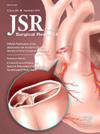比洛斯 II 与比洛斯 II + 博朗吻合术在胃癌胃切除术中的应用比较
IF 1.8
3区 医学
Q2 SURGERY
引用次数: 0
摘要
简介:远端胃切除术仍是胃癌的主要治疗方法,消化道重建是其中一项不可或缺的手术。在远端胃切除术中,继比洛氏 II 型吻合术之后采用布劳恩吻合术的情况很普遍。这项回顾性队列研究通过比较比洛斯 II(B-II)和比洛斯 II 加布劳恩(B-IIB)吻合术在胃癌治疗中的疗效和生活质量,评估了布劳恩吻合术的临床实用性:一项回顾性队列研究对2016年10月至2021年10月在宁波大学附属李惠利医院接受远端胃切除术治疗胃癌的377例患者的临床和病理资料进行了研究,其中185例患者接受了B-II吻合术,另外192例患者接受了B-IIB吻合术,分别组成B-II组和B-IIB组。对两组患者的基线特征、围手术期变量、短期和长期并发症以及术后1个月和1年的营养指标进行了比较。此外,还评估了术后6个月和1年的胃内镜检查结果。术后1年的生活质量采用欧洲癌症研究和治疗组织生活质量问卷--核心30进行评估:结果:两组患者的基线特征在统计学上无显著差异(P>0.05),证实了两组患者的等同性。所有377名胃癌患者均成功接受了根治性远端胃切除术,术中未进行任何程序修改。术中未出现并发症或围术期死亡率。显著差异包括手术时间延长(222.1 ± 41.0 分钟 vs. 199.4 ± 24.9 分钟,P 0.05)。术后 1 个月和 1 年的营养评估显示,两组患者的体重指数、总蛋白和血清白蛋白水平差异无统计学意义(均 P > 0.05)。手术后 6 个月和 1 年的胃内镜评估(包括食物残渣等级、胃炎严重程度、胃炎范围和胆汁反流)显示,两组之间没有显著差异(所有 P > 0.05)。在 1 年的随访中,两组患者均未出现肿瘤复发、肿瘤相关疾病死亡、术后并发症或其他疾病。此外,使用欧洲癌症研究和治疗组织生活质量问卷-核心进行的生活质量评估显示,两组在不同领域或项目上没有显著差异(所有P>0.05):结论:B-II和B-IIB吻合术的对比分析表明,术中参数、术后营养结果、胃内镜结果或术后生活质量均无明显差异。不过,采用博朗吻合术会延长手术时间,并可能增加术后内疝的可能性。本文章由计算机程序翻译,如有差异,请以英文原文为准。
Comparison Between Billroth II and Billroth II + Braun Anastomosis in Gastrectomy for Gastric Cancer
Introduction
Distal gastrectomy remains the predominant therapeutic approach for gastric cancer, with digestive tract reconstruction as an integral procedure. The implementation of Braun anastomosis following Billroth II anastomosis is common in distal gastrectomy. This retrospective cohort study evaluated the clinical utility of Braun anastomosis by comparing the outcomes and quality of life between Billroth II (B-II) and Billroth II with Braun (B-IIB) anastomosis in the treatment of gastric cancer.
Methods
A retrospective cohort study examined clinical and pathological data from 377 patients who underwent distal gastrectomy for gastric cancer treatment at The Affiliated Lihuili Hospital, Ningbo University, from October 2016 to October 2021.185 patients received B-II anastomosis, while the other 192 received B-IIB anastomosis, forming the B-II and B-IIB groups, respectively. Baseline characteristics, perioperative variables, short-term and long-term complications, and nutritional indicators at 1 mo and 1 y postsurgery were compared across both groups. Additionally, gastric endoscopy results at 6 mo and 1 y postsurgery were evaluated. Quality of life at 1 y postsurgery was assessed using the European Organization for Research and Treatment of Cancer Quality of Life Questionnaire-Core 30.
Results
Baseline characteristics between the two groups revealed no statistically significant differences (all P > 0.05), confirming their equivalence. All 377 patients successfully underwent curative distal gastrectomy for gastric cancer without intraoperative procedural modifications. No intraoperative complications or perioperative mortality occurred. Notable differences included extended operative time (222.1 ± 41.0 vs. 199.4 ± 24.9 min, P < 0.001), reduced postoperative nasogastric tube removal time (1.8 ± 0.9 vs. 2.2 ± 1.1 d, P < 0.001), decreased average gastric drainage volume (100.7 ± 35.2 vs. 112.2 ± 32.0 mL, P = 0.001), and increased incidence of internal hernia and ileus (4.7% vs. 1.1% and 8.3% vs. 3.2%, P = 0.038 and P = 0.035) in the B-IIB group compared to the B-II group. No significant differences were observed in estimated blood loss, lymph node dissection, postoperative flatus time, transition to a semiliquid diet, length of hospital stay, or short-term and long-term complications (all P > 0.05). Nutritional assessments conducted 1 mo and 1 y postsurgery indicated no statistically significant differences in body mass index, total protein, and serum albumin levels between the two groups (all P > 0.05). Gastric endoscopy evaluations at 6 mo and 1 y postsurgery, including food residue grade, gastritis severity, extent of gastritis, and bile reflux, demonstrated no significant discrepancies between the groups (all P > 0.05). At the 1-y follow-up, neither group exhibited tumor recurrences, deaths from tumor-related diseases, postoperative complications, or other diseases. Additionally, quality of life assessments using the European Organization for Research and Treatment of Cancer Quality of Life Questionnaire-Core revealed no significant differences across various domains or items between the groups (all P > 0.05).
Conclusions
A comparative analysis between B-II and B-IIB anastomosis demonstrated no notable variations in intraoperative parameters, postoperative nutritional outcomes, gastric endoscopic results, or postoperative quality of life. Nevertheless, incorporating Braun anastomosis can extend the duration of surgery and may elevate the likelihood of postoperative internal hernia.
求助全文
通过发布文献求助,成功后即可免费获取论文全文。
去求助
来源期刊
CiteScore
3.90
自引率
4.50%
发文量
627
审稿时长
138 days
期刊介绍:
The Journal of Surgical Research: Clinical and Laboratory Investigation publishes original articles concerned with clinical and laboratory investigations relevant to surgical practice and teaching. The journal emphasizes reports of clinical investigations or fundamental research bearing directly on surgical management that will be of general interest to a broad range of surgeons and surgical researchers. The articles presented need not have been the products of surgeons or of surgical laboratories.
The Journal of Surgical Research also features review articles and special articles relating to educational, research, or social issues of interest to the academic surgical community.

 求助内容:
求助内容: 应助结果提醒方式:
应助结果提醒方式:


